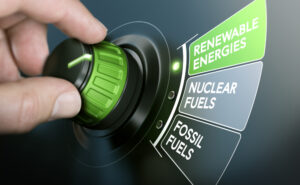Where to Invest During the Renewable Energy Transition

Today, the world is in the midst of an incredible energy transition. I call it the “Energy Disruption Triangle.”
I’ve been so fascinated by it that I wrote a book by the same name. I saw this coming a decade ago.
This transition is obeying my Three Laws of Technology.
The first is “Technology marches on.” No matter what is happening around us – recessions, depressions or even pandemics – technological change is inevitable and continues to happen.
My second law is “When it comes to technology, change happens much faster than anyone expects it will.” Just look how fast smartphones went from an idea to indispensable and a part of our everyday life.
The third law is perhaps the most telling: “New technology is almost always disruptive and transformative.” For example, the automobile changed America and the world.
The renewable energy transition, like most other transitions, is disruptive.
Dirty, polluting coal plants are closing left and right. They are being replaced by zero-pollution alternatives.
The Gods Are Smiling on Solar, Wind and Storage
Continual improvements in technology have led to modern solar panels with 22% efficiencies. And in another decade, panel efficiencies will likely increase by 50% or more.
This means we will get more power out of fewer panels.
For example, we have two 10-kilowatt (kW) solar arrays at our farm in Pennsylvania.

The one we installed eight years ago consists of 48 panels. Each is 17.5% efficient.
Our second 10-kW array was installed two months ago and consists of just 28 panels, but each is 22.5% efficient.
Our new array cost about 30% less than our old one. Technology marches on – higher efficiency, less material and lower cost.
Wind farms are increasingly moving 20 miles or more offshore. There, they are growing in size and power output.
Today’s wind generators are larger in size, are more efficient and can produce far more power than those developed just five years ago. The General Electric (NYSE: GE) Haliade-X is more than 850 feet tall.
Its fiberglass blades are more than 300 feet long, and the turbine can generate 12 megawatts (MW) of power. That’s enough to light up 16,000 homes.
Siemens‘ (OTC: SIEGY) new turbine, the SG 14-222 DD, is the current top dog in wind turbines. It can generate 14 MW.
Solar and wind have their obvious drawbacks, but energy storage systems fix those problems and more.
Storing energy allows the time-shifting of power from off-peak periods to peak usage periods. This flattens the overall demand curve, drastically reducing the need for natural gas-fired peaking plants.
Transportation: It’s Electrifying!
The sun is beginning to set on oil and natural gas too. The electrification of the transportation sector is firmly underway.
Electric buses are the only ones you can catch in Shenzhen, China. The city of 12.5 million replaced all 16,359 of its diesel buses with electric ones.
China itself has 385,000 electric buses. That’s 99% of the world’s electric bus fleet – bigger than the fleets of Los Angeles, Chicago, New York, Toronto and New Jersey combined.
As it electrified city buses, China quickly discovered two things that the U.S. is just now realizing.
Electric buses don’t belch tons of smog-creating pollutants. As a result, urban China’s population is breathing easier.
China also realized that though these buses come with higher price tags than diesel buses, they are far cheaper to operate and maintain.
This past July, electric vehicles (EVs) made up 18% of all automobile sales in Europe. Sales aren’t that high here in the U.S., but they are growing rapidly.
Plus, new EV charging locations are sprouting like weeds. Travelers can drive just about anywhere they want without range anxiety.
On a recent trip from Pennsylvania to Maine in our Tesla, my wife and I had no trouble finding charging stations. Most are conveniently located in retail areas. Great for food, restroom breaks or just stretching your legs.
What’s in It for Investors?
The transition to renewable energy is turning out to be one of the most profoundly transformative transitions the world has ever seen. And here’s the best part: It offers savvy investors huge profit opportunities.
But there’s one problem. The list of companies in the renewable energy sector is growing almost weekly.
For an investor new to the sector, the choices can be overwhelming. And as in any sector growing this rapidly, there are winners and losers.
But there’s a solution for that: renewable energy exchange-traded funds (ETFs).
Some investors are focused on solar energy. They might consider the Invesco Solar ETF (NYSE: TAN).
Others are interested in the entire renewable energy sector. That’s the focus of the Invesco WilderHill Clean Energy ETF (NYSE: PBW).
Finally, investors looking for companies reducing carbon have their own ETF. The VanEck Vectors Low Carbon Energy ETF (NYSE: SMOG) certainly has the appropriate symbol.
EVs… renewable energy… new technology… cutting-edge biotech… online learning… these are the areas in which my colleague Matthew Carr and I are investing. And you should be too.
Good investing,
Dave







3 Comments
[…] understanding of where XPeng stock price is headed next. For more information about Xpeng stock, renewables and more, sign up for our free Profit Trends e-letter […]
[…] understanding of where XPeng stock price is headed next. For more information about Xpeng stock, renewables and more, sign up for our free Profit Trends e-letter […]
[…] understanding of where XPeng stock price is headed next. For more information about Xpeng stock, renewables and more, sign up for our free Profit Trends e-letter […]
Comments are closed.